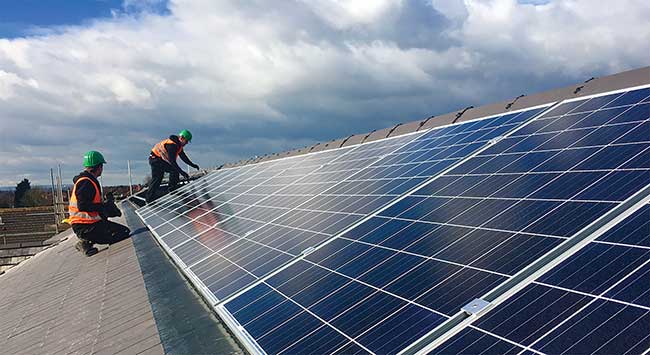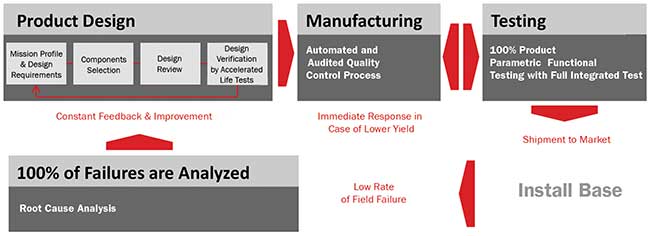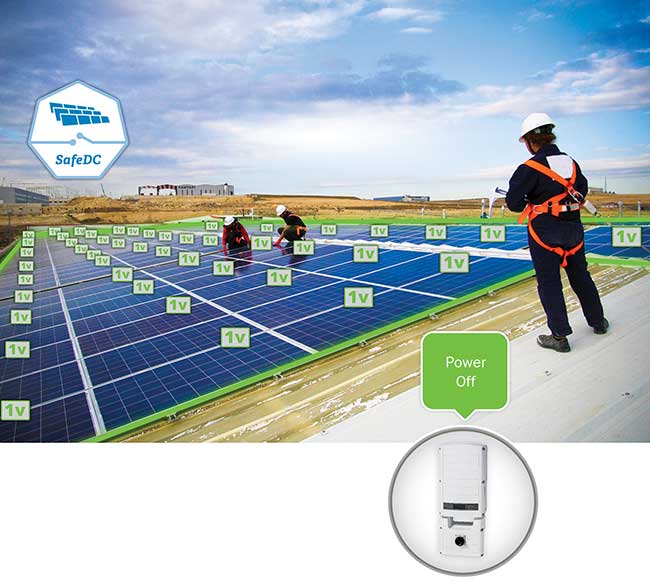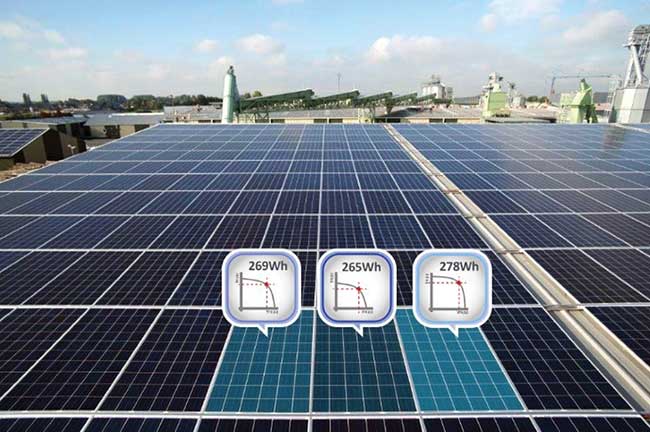Commercial PV systems are now considered long-term investments, lasting about 25 years. This makes it crucial to understand how every stage — from selection and installation to operation and maintenance — can impact the longevity and ROI of the systems.
LIOR HANDELSMAN, SOLAREDGE TECHNOLOGIES INC.
Making decisions that ensure the quality, durability and reliability of a photovoltaic (PV) is crucial for the development, installation and lifetime of a system. There are multiple ways in which these three attributes can be designed into all stages of the PV lifecycle in order to improve system performance. There are two factors in determining system components during the selection stage: vendors and products.
Vendor selection
Vendor selection is as important as product selection. As the relationship will be a lasting one that stretches over two decades, it is not unlike choosing a lifetime partner.

Proper installation is essential for maximizing profits in commercial photovoltaic systems. Courtesy of SolarEdge.
Specific PV vendor selection criteria should include research into the following characteristics that typify a potentially good vendor: market position; trustworthiness and reliability; stable financial models and bankability; and comprehensive pre- and post-sales services, such as ongoing support.
Worthwhile services that should be part of the offering include training and tools; project design; levelized cost of energy (LCOE) and ROI analysis; PV simulation and comparative system analysis; a rapid return merchandise authorization (RMA) process and technical support; fault detection; and executive reporting. These services are key not only to the success of the relationship, but also to the operation of the PV system.
Product evaluation
In addition to screening the vendor, it is important to carefully review and evaluate the products. One of the most important components when selecting a PV system is the inverter that influences 30 percent of the system costs, completely manages system production, and controls operations and maintenance (O&M) expenses. As such, an inverter, which accounts for only 10 percent of the actual system cost, is critical for the long-term financial performance of a PV system. Product quality, durability and reliability become especially important here. The amount of system installations worldwide, operational hours, product failure rates, diverse climate record and RMA rates are among key indicators of a product’s track record.
The quality of a product is determined by its design, components and manufacturing. A high-quality manufacturer will have component screening and quality assurance procedures already in place. There should also be multiple controls throughout the production processes — among them, ongoing testing for quality assurance. Full quality control should be performed on all production lines, including accelerated lifetime testing and root cause analysis on all product failures. These processes help ensure high-quality, long-lasting products. Third parties can guarantee the PV products comply with applicable regulatory requirements such as safety regulations, electromagnetic compatibility standards and grid compliance codes.

Depiction of SolarEdge’s product life cycle. Courtesy of SolarEdge.
Product reliability refers to consistent performance throughout the product’s lifetime. Reliable products have a reliability process embedded into all stages of design and production. The design stage should include a full review of the mission profile, design requirements, component selection and design verification with accelerated life tests. The manufacturing should be automated to decrease human error and include an audited quality control process.
Following this, fully integrated testing of product parameters and functionality should be performed. If any failures are registered, a full analysis should be conducted to reveal the root cause; any information gained from this analysis should be adapted to refine and improve product design and reliability.

Testing verifies that a product meets life expectancy and performance goals. Courtesy of SolarEdge.
Product durability refers to the capacity to withstand harsh environmental conditions. Since PV is often installed in tough environments, all equipment should be robust enough to function under tough conditions — wide temperature ranges, humidity, dust, rain, saline and ammonia. Ratings such as IP65 and IP68 can indicate a product’s durability, longer warranty periods and the results of product testing. Burn-in, thermal cycling and damp heat testing are some of the dedicated tests that are run until a product wears out. Such tests accelerate the product’s lifetime to verify that it meets life expectancy and performance goals.
Installing PV systems
The next stage — installation — is essential for maximizing profits in commercial PV systems. There are many key parameters to consider for correct installation and improvement of systems’ quality, reliability and durability.
During site selection, standard considerations (including orientation, inclination and shading) need to be made. Possible corrosion should also be considered. This can refer to land corrosion or chemical corrosion, either of which may impact equipment functionality.
For example, commercial installations of PV systems in the agricultural sector are susceptible to ammonia corrosion if the products are not designed for such an environment.

SolarEdge SafeDC with module-level shutdown. Courtesy of SolarEdge.
In design and planning of the system, structural load, wind and grounding are all important factors to consider. One of the most important aspects is the physical installation of the components. This includes well-planned configurations, securing wiring, correct labeling, sensors and conduit bodies, as well as fully closing all connectors. Any missteps in these areas could not only impact a system’s energy production, but also severely damage it. For instance, if connectors are not properly closed, arcs may occur and potentially ignite a fire. One of the best ways to ensure proper installation is with in-depth training in system basics, technical details, design rules, safety guidelines and best practices.
Maintenance of an installed PV system is pivotal to ensure that it continues to produce at the highest possible level, despite aging. A system with a 25-year life expectancy could likely be impacted by aging mismatch, unpredictable environmental and obstruction changes (e.g., erecting antennas), and defective modules. Prepare for this at the product selection stage. Product warranties reflect a company’s confidence in quality, reliability and durability. Those products with a longer warranty or an easily extendable one can increase the lifetime of a commercial PV system. Other considerations include selecting low-cost hardware replacements for out-of-warranty products and identifying ways to minimize expensive inventory stock using forward compatibility equipment that also provides design flexibility.

Module-level maximum power point tracking (MPPT) can help hedge against mismatch losses. Courtesy of SolarEdge.
Preventative maintenance is a significant and expensive part of maintenance activity; this is necessary to prevent larger losses. Preventative maintenance includes general site annual inspection, detailed visual inspection, DC and AC electrical testing, thermal imaging, IV curve testing, and mechanical inspections. However, with strategic PV asset management tools, preventative maintenance can become more cost-effective and time efficient. Online fleet management, automatic module-level alerts regarding system issues, remote troubleshooting and performance, consumption, and export monitoring are all tools that can increase the longevity of PV systems, while also making O&M more efficient. By using such PV asset management tools, quality, durability and reliability can be extended throughout a commercial PV system’s lifetime.
Safety in PV
It is important to note how safety issues can impact commercial PV systems, as safety concerns can sometimes prevent installation of commercial PV systems. Some safety concerns originate from buildings often having roofing material that could be flammable or made of bitumen or expanded polystyrene material. Also intensifying this concern: Commercial buildings are high-value assets that could be costly to repair in the event of fire, property loss or business interruptions.
Another impediment is that some insurance companies may not extend coverage if PV systems don’t provide proper safety for firefighters and the assets themselves. To address these concerns, high-quality systems with enhanced safety features can be installed. Safety requirements vary from region to region, so local guidelines should always be followed. One of the highest safety standards includes reducing DC voltage to safe levels in modules and DC string wires when the inverter is turned off or when the AC breaker is disconnected. In terms of arcs, high safety standards are met when inverters and panels can be shut down when exposed to extremely high temperatures or electric arcs. Employing enhanced safety features allows commercial PV systems to benefit from advanced technology that improves quality and longevity.
While it is common to consider quality, durability and reliability at the early stages of deploying a commercial PV system, these qualities should be actively designed into every stage of its life cycle. By considering the impact each stage has on the longevity of a commercial PV system, the industry can benefit from more profitable systems and improved positioning in the energy market.
Meet the author
Lior Handelsman is the founder of SolarEdge Technologies Inc. and serves as the company’s vice president of marketing and product strategy; email: [email protected].